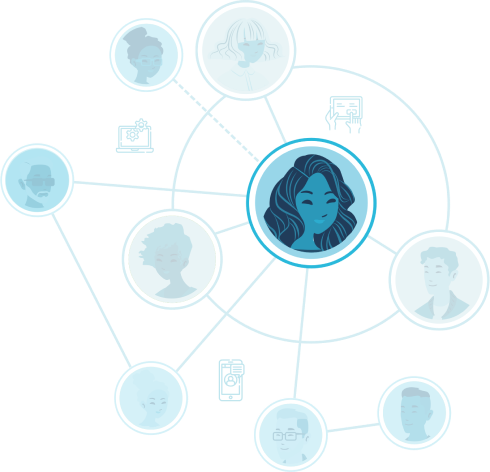Step 2. Shore Up Support Networks: Ensuring Every Student Has Access to a Web of Supportive Relationships


Guiding questions:
-
Who are the close relationships students are already turning to for support beyond your school or program?
-
Is there at least one person that the student identifies as someone they trust to turn to inside your school or program?
-
How well are the individuals in a student’s support network connected to one another?
-
How does your organization securely share information about students among their identified support networks to help ensure that those individuals interacting with students can best support them?
-
How intentionally have you built opportunities to practice skills in relationship building into your approach to social and emotional learning and well-being?

Search Institute researchers and practitioners have arrived at a surprisingly simple conclusion: nothing—nothing—has more impact in the life of a child than positive relationships.”
PETER BENSON, FORMER CEO AND PRESIDENT OF SEARCH INSTITUTE
Based on youth development research, a close-knit web of strong ties—or strong relationships—is critical to helping students thrive. An effective web of support typically contains at least one anchor or especially strong relationship. Research has shown that a web is also more supportive and resilient if the members of that web know one another, particularly for academically at-risk students or those dealing with adverse life experiences. Systems committed to shoring up strong support networks for their students should measure:
- The number of peers and adults a student turns to for different supports
- The sources of supportive relationships formed (including whether a student met someone through an existing relationship or a specific mentor) and how those individuals are connected to each other and the student
- A student’s level of comfort in seeking, activating, and mobilizing support from individuals in their network
-
1
Building webs of support buffers risk.
Oftentimes, programs try to make sure students have access to a single “mentor” or a “caring adult.” Although that’s a great first step, it’s incomplete. Research from the Center for Promise is clear: students benefit from a web of close, supportive connections, rather than a single mentor, to turn to for support. As the number of strong ties a student has access to goes up, so do academic motivation, social and emotional skills, and students’ ability to take responsibility for their own actions. Furthermore, risk behaviors decline with additional supportive relationships.
-
2
Intentional efforts to address adverse life experiences with varied types of support may be necessary when social support is not enough.
Young people who have experienced high levels of adversity and trauma may require mental health and social services beyond what relationships with family, school personnel, and friends can provide. Professional and instrumental support may be needed in addition to social support. Researchers have found that it can be especially difficult for young people with five or more adverse childhood experiences to form connections with new people, which makes establishing trust essential. Additionally, plugging in mentors as stop-gap solutions where other professional supports or public subsidies are needed could backfire.
-
3
Support can take many forms—emotional, informational, appraisal, and instrumental—all of which can promote student success in different ways.
One reason a web of support is so powerful is that different relationships can provide different types of support depending on a student’s needs and circumstances in a given moment.
-
4
Anchor relationships act as a gateway to a web of support.
Within a web of support, a single “anchoring” relationship allows the young person to access available community assets and to recognize and act upon his own internal strengths. Some researchers have defined this anchor as a person who is not a family member or a paid youth worker, and who provides deep, unconditional support.
-
5
“Close connector” mentors may have the greatest impact.
Youth paired with mentors identified as “close connectors” show the greatest improvements in a variety of outcomes, including improved parent-child relationship quality, increased help-seeking behaviors, and greater extracurricular activity participation. “Close connectors” not only form close, trusting relationships with mentees, but also proactively connect mentees to other relationships and networks.
-
6
Providing support can have upsides for the “supporter” too.
Peers and near peers can be valuable sources of support. These relationships not only benefit the student receiving the support, but also appear to motivate the individual empowered to provide support. For example, high school students giving motivational advice to younger students earned higher report card grades in both math and a self-selected target class over an academic quarter.
Note: Open the PDF to see a complete list of research citations.

Developing strong relationships involves compassion and investment. Not everyone in a web of support needs to have complete information, they just need to be invested in having a positive relationship.”
Joan Wasser-Gish, Director of Strategic Initiatives, Center for Optimized Student Support
You can’t expect students to get ahead if they lack webs of support to get by. Ensuring that students have a web of supportive connections is critical to strengthening students’ networks. The following strategies can help you build support networks for all students:
Click on the green text to see more.
If you’re trying to drive better academic outcomes and skills development → Keep educators in the wraparound services and basic needs loop:
Both K–12 and postsecondary systems are increasingly focused on provisioning “wraparound” supports to ensure students have the resources they need to learn. Some integrated student support programs attribute their success to the idea that educators are better able to serve their students academically when they have a better understanding of their personal lives. As a result, teachers’ academic decisions can be sensitive to the non-academic factors present in students’ lives. For example, one evidence-based integrated support model called City Connects provides non-academic and academic support to low-income students by assigning coordinators and existing staff members to assess each individual student’s needs and connect them to in- and out-of-school supports.
If you’re introducing new staff or mentors into student support networks → Integrate a Critical Mentoring agenda into program design and training:
Support can be delivered in a manner that ignores students’ strengths and focuses on deficits if it discounts existing assets in students’ homes and communities. Factors like race, class, sexuality, and gender all contribute to students’ identities; but mentorship and support models do not always recognize or address these facets head-on in how they train or support mentors or staff. Additionally, if programs broker new connections between White mentors and non-White mentees or students, they may be urging students of color to assimilate to dominant culture rather than recognizing and investing in their own culture. Instead, a Critical Mentoring agenda to brokering support recognizes the assets in both students’ existing networks and identities, while providing deliberate opportunities for students and mentors alike to celebrate the strengths, cultures, and values within that network.
If you’re scaling student support structures → Build on existing advisory structures and peer-to-peer connections and cohorts:
Some schools and institutions have already invested in systems that build close student-to-student and student-to-staff connections, such as advisories. Deliberate designs and measures can ensure advisory becomes a vehicle through which every student has a robust support network within school. For example, EL Education’s Crew model involves engaging with the same peers and crew leader on a regular basis (daily or multiple times per week), and they often remain together year after year. You can scale student support without advisory teachers or full-time staff members by connecting students with their peers and near peers. This untapped source of support can be quite effective because similar age and circumstances can inspire greater confidence and trust. Peers can also foster a sense of accountability. For example, the Atlanta-based Forest School enlists peers to support one another through its Running Partners approach, which pairs students with an accountability partner to help them set and reach their goals.
If you’re supporting students in building their relationship skills → Empower them to lead conversations with their support networks:
Investing in stronger support networks in school is often well-intentioned. But it can backfire if these investments occur absent clear diagnostics identifying whom students are turning to within and beyond school in the first place. Programs can leverage the strategies in Step 1 to gather reliable information on the staff, family, community, and peer connections already providing support to students before adding new relationships to that mix. From there, they can empower students to lead conversations with their support networks. For example, Achievement First’s Greenfield school model has implemented a structure called Dream Teams, also referred to as a “community of champions,” composed of students’ parents, caregivers, extended family members, or neighbors. Dream Teams meet quarterly with students and their teachers. The approach specifically focuses on building student agency; students lead their quarterly Dream Team meetings to update their web of support on their goals and progress.
If you’re struggling to connect the individuals within a student’s web of support → Build shared student profiles that sit alongside academic data:
As more systems have tried to improve student support models, many have created student or learner profiles where relevant information about students’ goals, challenges, and experiences can sit alongside academic data. To make these part of a more coherent web-of-support approach, systems can ensure that multiple stakeholders have access to the learner profile and the ability to contribute to the profile over time. This can decrease coordination costs across the student’s web of support.
If you’re determining how to identify and disseminate critical student information securely → Evaluate information to prioritize which individuals need to know what:
To maintain student privacy, prior to engaging in this work, stakeholders should think deeply regarding the information they are collecting, how it will be used, who has access, and how it is stored. Information should be circulated across students’ support networks on a need-to-know basis that is appropriate in a given context. In instances that involve sensitive information, individuals can be empowered to encourage extra support for a student without sharing specifics. For example, law enforcement may use the phrase “handle with care” to indicate to school administrators that a particular student may be experiencing a difficult situation.
-

Connected Scholars arms college students with the agency and skills to build their own support networks in school.
Connected Scholars is a research-informed course designed to meet the needs of high schools, colleges, and universities interested in implementing a mentoring program for its students. It specifically aims to equip low-income and first-generation college students. Instead of matching students with assigned mentors, students are trained to understand the value of building their social capital, then learn and practice networking and relationship-building skills to expand their networks. Read more here.
Evidence of impact
Young people who completed four Connected Scholars sessions on learning how to recruit mentors at the start of college had a higher GPA at the end of the school year.
Sample data collection strategy
Students respond to a series of questions related to academic and career networking, such as:
- I introduced myself to professors and support staff.
- I met with professors and support staff to discuss my goals and interests.
- I reached out to professionals in a career or interest area of mine.
- I got to know at least one professor well.
- I asked a professor or support staff for career advice.
-

This Way ONward combines webs of support and youth employment for first-time employees.
Gap Inc.’s This Way ONward (formerly This Way Ahead) model offers on-ramps to paid work to young people who are low-income or currently disconnected from work or school. The program has deliberately constructed distinct but connected roles that its community partners, employees, and supervisors play to shore up a web of support around young, first-time store associates. All This Way ONward participants are paired with a job coach from a local nonprofit organization, an on-the-job “big sib,” a store leader, and a store manager. These individuals are all expected to communicate with one another in an effort to anticipate challenges and set young employees up for success. Read more here.
Evidence of impact
A Gap Inc. survey showed that 72% of alumni (2007–2016 participants) go on to secure stable employment compared with 55% of their similarly-situated peers not part of This Way ONward.
Sample data collection strategy
Gap Inc. set up a separate job code in their HR systems to “tag” anyone who gets hired through This Way ONward. That’s helped the company track business outcomes such as retention, performance, promotion, and diversity generated through the model.
Which members of your staff, team, or broader community are called upon to support students? How do those individuals communicate and share information with students but also with one another? Can all students identify at least one person they trust to turn to inside your school or program? Develop a plan to shore up your students’ support networks.
Download our guided worksheet to keep track of your progress while going through the playbook.
Customize a plan-
Center for Promise’s Defining Webs of Support framework
This framework provides further guidance around webs of support. It describes the importance of recognizing youth are active agents in relationships; relationships are embedded within a broader ecology of relationships; and different adults provide different types of support.
-
Dr. Torie Weiston-Serdan’s Critical Mentoring: A Practical Guide
This book details the critical mentoring approach created by Dr. Tori Weiston-Serdan. It provides a foundation in critical race theory, cultural competency, and intersectionality. Dr. Weiston-Serdan’s team offers services to embed equity-focused practices into training mentors.
-
Education Redesign Lab’s Children's Cabinet Toolkit
This free guide focuses on building municipal partnerships to integrate social services functions to best support young people.
-
EL Education’s We Are Crew: A Teamwork Approach to School Culture
This workbook provides case studies and templates for schools to design advisory models that provide students with year-over-year support networks.
-
CERES Institute for Children & Youth’s Using the Web of Support Framework tool
This tool was designed by Shannon Varga and Jonathan Zaff for use by youth-serving professionals and youth. It identifies important structures within a web of support, best practices, and sample prompts.
-
MENTOR's Becoming a Better Mentor
This free guide offers real-world advice for mentors and evidence-based strategies on topics such as emotional support and empathy, cultural humility, attunement, and honoring youth voice.
-
City Connects Actionable Evidence Case Study
This free case study details student support data collection and sharing practices uses the City Connects MyConnects data system.
-
Fostering Relationships with Young People
This tool provides an overview and “quick tips” on how caring adults can talk about mental health while supporting young people.
-
NCERA's Building Social Capital on Purpose Toolkit
This toolkit provides best practices for building youths' social capital, using the 4-H youth development approach as a foundation.
